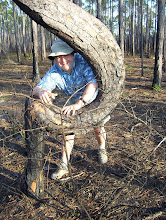 On the day Dr. Crass visited the Hill Country, he also joined several of the Elementary students at Hill Country Montessori school, for a walk to a nearby farm ruins. The ruins are accessible only by footpath, and are located in the natural area of Serenbe Community. They consist of an old family cemetery (with graves from the mid-to-late 1800s), substantial remains of a farm outbuilding for storing dairy products, and a couple of stone walls from a large bank barn. The farmhouse is long gone, a victim (it is said) of a fire intentionally set back in 1940, so the landowner could avoid paying a "window tax". In the photo above, Dr. Crass is talking with the students about the grave sites (just left of the photo), and what can be learned from them through various archaeological techniques.
On the day Dr. Crass visited the Hill Country, he also joined several of the Elementary students at Hill Country Montessori school, for a walk to a nearby farm ruins. The ruins are accessible only by footpath, and are located in the natural area of Serenbe Community. They consist of an old family cemetery (with graves from the mid-to-late 1800s), substantial remains of a farm outbuilding for storing dairy products, and a couple of stone walls from a large bank barn. The farmhouse is long gone, a victim (it is said) of a fire intentionally set back in 1940, so the landowner could avoid paying a "window tax". In the photo above, Dr. Crass is talking with the students about the grave sites (just left of the photo), and what can be learned from them through various archaeological techniques.  The object of our quest, though, was still a few minutes' walk along a wooded hillside, to an ephemeral stream in a gully, where the ruins of the dairy building and bank barn are located. The dairy structure is the more intact, and intriguing, of the two. It had double-thick walls, and two small rooms partially sunk into the ground, with pits in their centers (for keeping milk in cold storage, perhaps?). The rock walls, though moss-covered in many places, are still fairly sturdy, the gabled end wall still prominent. Dr. Crass talked with us about how to date the building: if we were to locate a nail that once might have held the roof together, then we could tell by the kind of nail about when the building was constructed. Late 1800s, most likely.
The object of our quest, though, was still a few minutes' walk along a wooded hillside, to an ephemeral stream in a gully, where the ruins of the dairy building and bank barn are located. The dairy structure is the more intact, and intriguing, of the two. It had double-thick walls, and two small rooms partially sunk into the ground, with pits in their centers (for keeping milk in cold storage, perhaps?). The rock walls, though moss-covered in many places, are still fairly sturdy, the gabled end wall still prominent. Dr. Crass talked with us about how to date the building: if we were to locate a nail that once might have held the roof together, then we could tell by the kind of nail about when the building was constructed. Late 1800s, most likely. 
Dr. Crass was thrilled by our find. Curiosity sparked, he studied the stone walls carefully, as if trying to read in their patterns the story of the building's origins. On our return walk, he wove nets of possibilities for future study of the site, in which an archaeological field program might take up residence there, piecing together the story of the farm, unearthing relics of a dairy operation the first few decades after white settlement (or perhaps occupation is a better word). There is something haunting about a ruins. Crumbling stone walls embody mystery, point to questions difficult to answer, prompt the imagination to fill in the gaps. There is a lot of room for imagining the past, here in the Chattahoochee Hill Country.

No comments:
Post a Comment